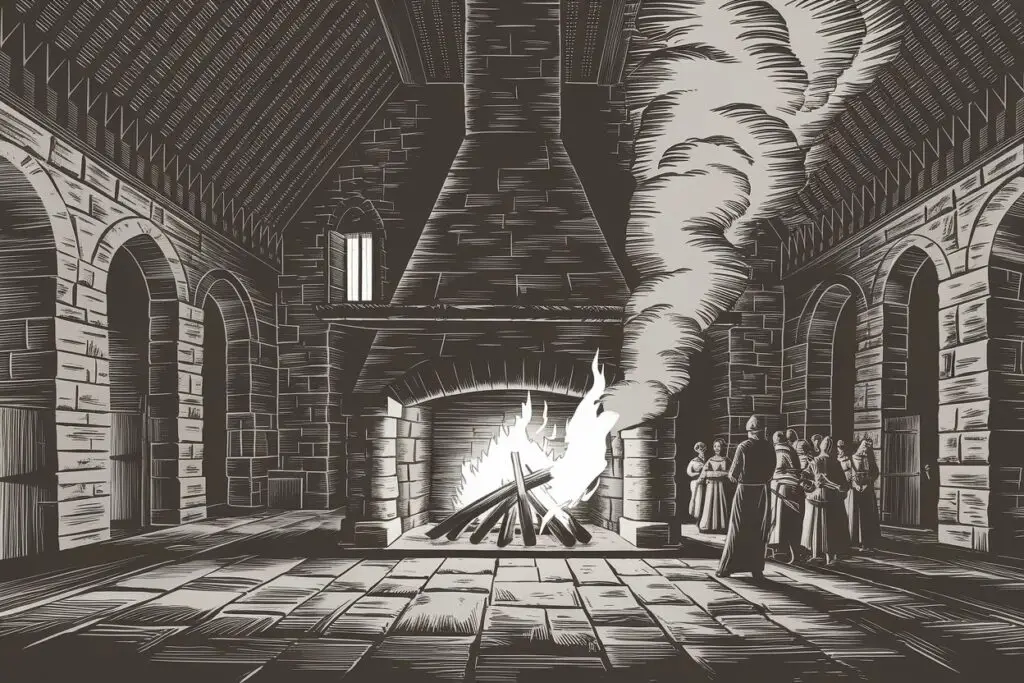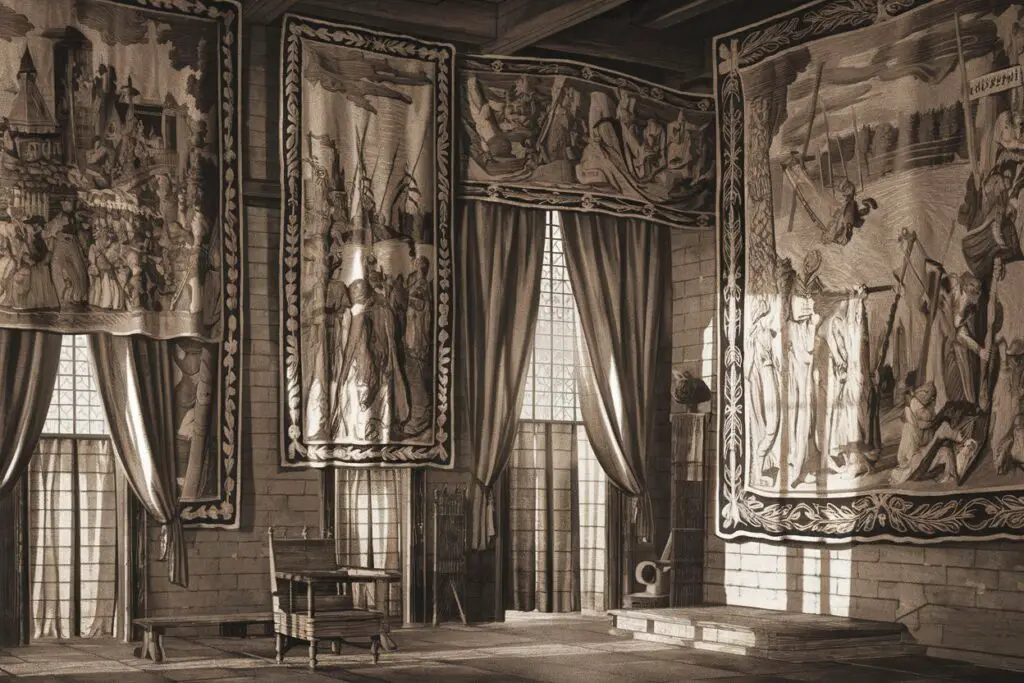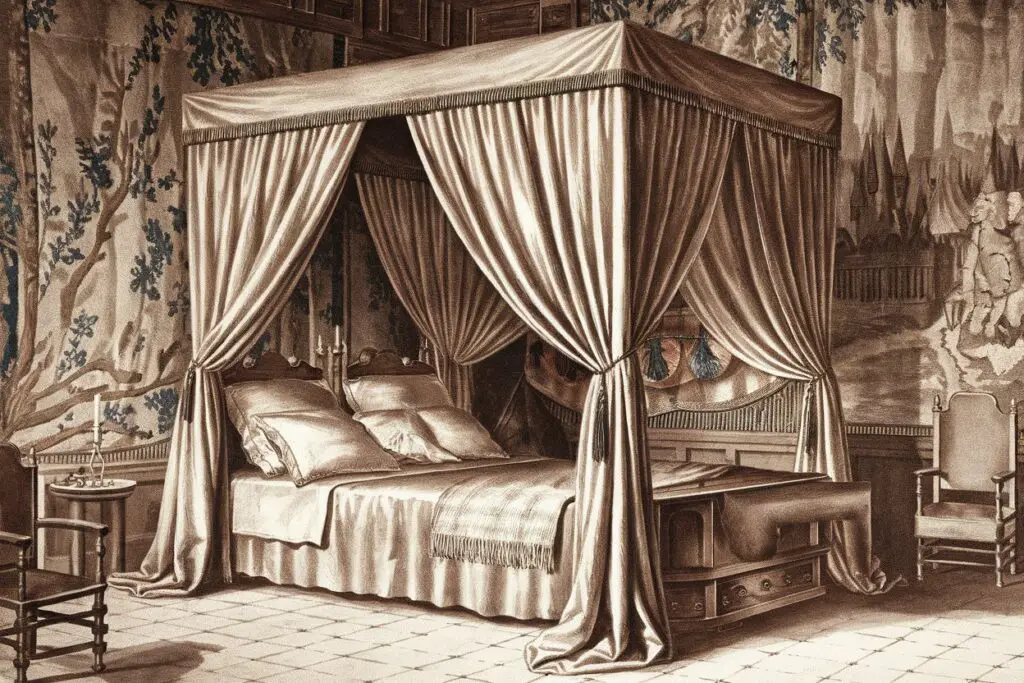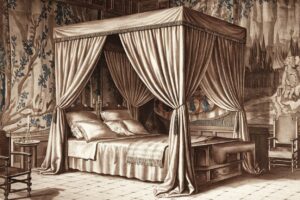Massive Fireplaces—The Heart of Medieval Heating
In the cold, drafty halls of medieval castles, massive fireplaces were more than just decorative features—they were essential for survival. These grand hearths, often spanning entire walls, were designed to counteract the chill of thick stone walls and high vaulted ceilings. Built from large stone blocks, some fireplaces measured up to 10-15 feet wide and 6-8 feet tall, allowing them to accommodate roaring fires that could burn for hours. Their placement was strategic, often found in great halls and private chambers where they could provide warmth to those gathered nearby.

Beyond heating, these fireplaces played a crucial social role. The great hall fireplace was a focal point of castle life, where lords, knights, and servants would congregate for warmth, meals, and storytelling. The heat from these fires also radiated into the surrounding stone, slowly releasing warmth even after the flames had died down. Some castles, like Rochester Castle, had fireplaces built into the walls to heat both the room and the stone, improving heat retention. In monasteries, such as Rievaulx Abbey, large fireplaces were kept burning for months to ensure warmth for the monks during long winters.
While effective, open fireplaces were far from efficient. Heat often escaped through large chimneys, and keeping a fire going required a constant supply of wood—typically hardwoods like oak, which burned longer and hotter. Some castles, such as Malbork Castle, developed more advanced systems where heat was stored in stones and distributed through channels, helping to conserve fuel. Despite their inefficiencies, these massive fireplaces remained the primary source of heat in castles for centuries, offering both warmth and a central gathering place in the harsh medieval climate.
Thick Stone Walls and Insulation Techniques
When we think of medieval castles, we often picture towering stone walls—imposing, yes, but not exactly cozy. Yet, these massive walls played a surprisingly effective role in keeping the cold at bay. Their secret? Thermal mass. Built from dense stone, often ranging from 6 to 12 feet thick, these walls absorbed heat during the day and slowly released it at night, creating a rudimentary but effective form of temperature regulation. This was particularly beneficial in regions with harsh winters, where maintaining indoor warmth was a constant struggle.
But walls alone weren’t enough. Medieval builders employed additional techniques to enhance insulation. Many castles had double-layered walls with a cavity filled with rubble or mortar, which helped reduce heat loss. Wooden paneling was sometimes added to interior walls to create an extra barrier against the cold, while straw or animal hair was occasionally mixed into plaster for additional insulation. Even window design played a role—medieval castles often featured small, south-facing windows to maximize sunlight while minimizing heat loss. At night, heavy tapestries or wooden shutters covered these openings, further improving insulation.
While medieval insulation techniques were rudimentary by modern standards, they were remarkably effective for their time. In fact, many principles used in castle construction—such as thick walls and strategic window placement—are still employed in energy-efficient architecture today.
Heavy Tapestries and Curtains to Block Drafts
Medieval castles, with their towering stone walls and cavernous halls, were notoriously difficult to keep warm. One of the most effective—and often overlooked—methods of insulation was the use of heavy tapestries and curtains. These weren’t just decorative flourishes; they played a crucial role in blocking drafts and trapping warmth within rooms. Thick, woven fabrics, often made from wool or linen, were strategically hung on walls to create an insulating barrier against the cold stone. In some cases, animal furs were even placed behind tapestries for added warmth, demonstrating an early understanding of thermal insulation principles.

Beyond wall coverings, large curtains were draped across doorways and windows, particularly in bedchambers and great halls. Since glass windows were rare in medieval times—only becoming widespread in castles by the 13th century—these fabric barriers helped minimize heat loss through open or poorly fitted wooden shutters. In noble households, richly embroidered tapestries also served as status symbols, illustrating scenes from mythology, religious stories, or family heraldry. Their dual function—both practical and ornamental—made them a staple in castle interiors. While not as efficient as modern insulation, these textile solutions significantly improved the livability of medieval castles, showcasing the ingenuity of historical heating techniques.
Layered Clothing—Wearing Wool, Fur, and Linen Indoors
In the absence of modern heating, medieval castle dwellers relied on layered clothing as a primary defense against the cold. Wool, fur, and linen were the most commonly used materials, each serving a distinct purpose in insulation. Linen, worn as an undergarment, was breathable and helped wick moisture away from the skin, keeping the wearer dry. Over this, people layered woolen garments, which provided superior insulation due to their dense weave that trapped heat effectively. The wealthier classes could afford fur-lined cloaks and robes, often made from fox, beaver, or ermine, which added an extra layer of warmth and also served as a status symbol.
The effectiveness of layering lay in its ability to trap warm air between each layer, creating a buffer against the cold. This technique was particularly important in stone castles, where thick walls retained cold temperatures and drafts were common. Accessories such as hats, gloves, and hoods further prevented heat loss, particularly from the extremities. Social class played a significant role in clothing quality—while nobles had access to the finest materials, peasants relied on simpler woolen garments, sometimes reinforced with additional layers of coarse fabric. This strategic use of textiles, combined with communal living and other heating methods, helped medieval inhabitants endure harsh winters within their drafty stone fortresses.
The Role of Canopy Beds and Heated Blankets
Medieval castles were notoriously difficult to heat, with their towering stone walls retaining cold rather than warmth. To combat this, people relied on layered bedding and enclosed sleeping arrangements to preserve body heat. Canopy beds, often associated with nobility, were not just decorative but served a crucial function in insulation. These four-poster structures were draped with thick, heavy curtains made of wool or linen, creating a microclimate that trapped warmth and shielded sleepers from drafts. By enclosing the bed space, body heat was retained, making frigid castle nights more bearable.

Beyond the bed structure itself, heated blankets played an essential role in personal warmth. These were often crafted from wool or lined with fur for added insulation. In wealthier households, bed warmers—metal pans filled with hot coals—were used to preheat bedding before sleep. Another common practice involved heating stones or bricks by the fire, then wrapping them in cloth and placing them under blankets to provide lasting warmth. These simple yet effective techniques allowed castle dwellers to endure harsh winters without modern heating, demonstrating medieval ingenuity in adapting to their environment.
Underground Heating Systems Like the Roman Hypocaust
The Roman hypocaust was one of history’s earliest forms of central heating, an engineering marvel that allowed for controlled indoor warmth long before modern radiators. Developed by the Romans around the 2nd century BCE, this system used an underground furnace (praefurnium) to generate heat, which then circulated through an open space beneath the floor, warming the rooms above. Floors were supported by small pillars, called pilae stacks, allowing hot air to move efficiently. Some hypocausts even had hollow wall channels (caliducts) to distribute heat further, ensuring a more even temperature throughout a building.
Though this technology declined with the fall of the Roman Empire, its principles persisted in medieval Europe, particularly in monasteries and certain high-status castles. Northern European adaptations incorporated heat-retaining granite stones and underground chambers to provide warmth, though these systems were expensive and labor-intensive to maintain. Unlike the more common fireplaces of medieval castles, which provided localized heat, hypocaust-like systems offered a more uniform warmth. However, their complexity and cost meant they remained rare outside of elite settings. While not widespread, the hypocaust’s legacy influenced later heating innovations, serving as an early precursor to modern underfloor heating systems.
Huddling Together—How Communal Living Helped Retain Warmth
Medieval castles were cold, drafty places, but people had one very reliable source of warmth—each other. Communal living wasn’t just a matter of social organization; it was a survival strategy. The great halls of castles were not only gathering places for feasts and meetings but also served as heat reservoirs, where the sheer number of bodies helped maintain a tolerable temperature. When dozens of people gathered in one space, their collective body heat significantly warmed the room, making it a practical alternative to modern central heating.
Sleeping arrangements also reflected this need for warmth. Lower-ranking members of the household, including servants and soldiers, often shared beds or slept side by side on the floor near the hearth. This practice, while born of necessity, was commonplace in medieval society. Even wealthier individuals, despite having private chambers, relied on thick curtains around their beds to trap heat—essentially creating a microclimate within their sleeping space.
In some cases, warmth came from more than just human bodies. In medieval Europe, particularly in colder regions, animals were sometimes housed in the same structures as people. This was common in housebarns, where livestock and humans coexisted under one roof. The body heat from cows, sheep, and other animals contributed to the overall warmth of the living quarters, a practice still observed in some rural communities well into the modern era.
Beyond sleeping and gathering, communal activities contributed to warmth as well. Kitchens, for example, were among the warmest places in a castle due to the constant presence of open flames. It wasn’t uncommon for people to linger in these spaces, whether to prepare food, complete daily tasks, or simply escape the chill of stone walls. Even social traditions, such as storytelling and group work, were often conducted in close quarters to maximize warmth.
Ultimately, communal living wasn’t just about convenience—it was a necessity in an era without modern insulation or heating systems. By staying close together, medieval people made the most of their available resources, demonstrating a keen understanding of how to survive harsh winters in even the most inhospitable of castles.







